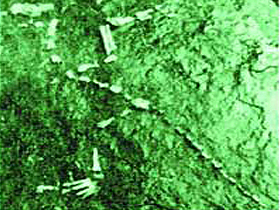In pointing to Archaeopteryx as an intermediate form, evolutionists began with the assumption that it was the earliest bird-like creature on Earth. However, the discovery of certain far older bird fossils displaced Archaeopteryx from its perch as the ancestor of birds. In addition, these creatures were flawless birds with none of the supposed reptilian features attributed to Archaeopteryx.
 The Protoavis fossil, estimated to be 225 million years old, demolished the theory that Archaeopteryx, a bird 75 million years younger than it, was the ancestor of birds. |
The most significant of them was Protoavis, estimated at 225 million years old. The fossil, whose existence was announced in a paper in the August 1986 edition of the magazine Nature, demolished the idea that Archaeopteryx, 75 million years younger was the forerunner of all birds. Its bodily structure, with hollow bones as in all other birds, long wings and traces of feathers on those wings showed that Protoavis was capable of perfect flight.
N. Hotton of the Smithsonian institute describes the fossil thus: "Protoavis has a well-developed furcula bone and chest bone, assisting flight, hollow bones and extended wing bones . . . Their ears indicate that they communicate with sound, while dinosaurs are silent."195
The German biologists Reinhard Junker and Siefried Scherer describe the blow dealt to evolutionist theses:"Because Archaeopteryx is 75 million years younger than Protoavis, it emerged that this was a dead end for evolution. Therefore, the idea put forward by the proponents of creation that there are no intermediate forms, only mosaic forms, has been strengthened. The fact that Protoavis resembles modern birds in many ways makes the gap between bird and reptile even more apparent."196
Furthermore, the age calculated for Protoavis is so great that this bird-again according to dating provided by evolutionist sources-is even older than the first dinosaurs on Earth. This means the absolute collapse of the theory that birds evolved from dinosaurs!
195. Reinhard Junker, Siefried Scherer, Enstehung und Geschichte der Lebewesen, Wegel Biologie, Brühlsche Universitatsdruckerei, Giessen, 1986, p.175.
196. ibid.


